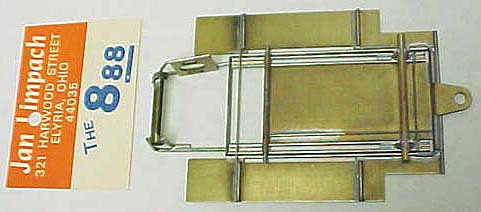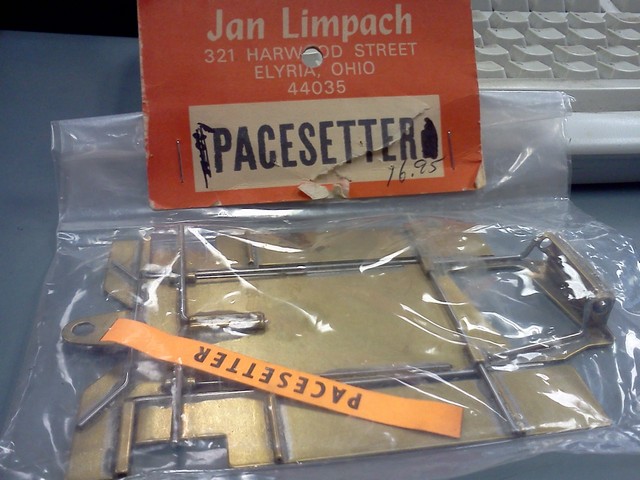I don't think that there is one reason why commercial racing ended so suddenly, but here is what i have seen. There were home sets made before commercial raceways. The home sets started out in 1/32 scale. As a child (born in '58) in the early sixties, as my older sister carted me around to her friend's houses, i saw many a 1/32 scale slot car track, along with train sets, in basements. Also in the early 60's the h.o. scale home sets were getting popular. So the slot car hobby started out marketed towards home set racing.
Then more hobby manufacturers jumped in (such as Monogram, AMT, Revell- note plastic model makers) making cars, accessories and race sets for home use. 1/32 scale clubs seem to have always been popular. The other dynamic is the boom of commercial raceways and now companies making 1/24 commercial slot cars and accessories. Then there were the slot car/model kit magazines. The slot car articles in these magazines seem mostly about 1/24 scale cars, and all of the racing articles were geared towards commercial track racing and building.
Did all of these groups ever get together? Namely the manufactuers of home and commercial cars, race sets, and accessories, the commercial track industry, and the magazines which was the consumer's source of the current happenings in the hobby? I ask because of the 2 dynamics going on- the home set race set crowd and the commercial raceway crowd.
As i look back to the 1965-1967 era of commercial raceway cars and accessories, it seems that new products werre being made so quickly, with constant improvements, that you could buy a car back then only to find that what you just purchased was not competitive in a race, which must have been very discouraging. The average person buying a rtr or a kit car could not compete with a scratchbuild with a rewound hot motor. Hobby manufacturers were creating a product line that did not match the serious racing at a commercial raceway, yet they expected their product line to be sold at a hobby shop-commercial raceway. Sales began to drop for these types of companies (e.g. Revell, Cox, AMT, Monogram) and small cottage industry companies making performance parts geared towards the more serious racer were picking up. The novelty/excitement of the newbie began to diminish, leaving mostly racers at commercial raceways left. This making the slot car commercial raceway business appear to have been a fad that came and went rather suddenly.
Here is part of an article I read in the October 1966 issue of Model Car Science entitled "Is 1/32nd scale slot racing dead??" (the article compares 1/32 home/club racing to 1/24 scale commercial racing): What we're saying, in effect is not that American Thumbs should turn up their knuckles at 1/24; but rather that the whole sport would be certainly healthier if a few more companies paid a bit more attention to 1/32nd...and HO, for that matter! The heavy emphasis on commercial racing is simply hurting the entire scene; who wants to take up racing if all the good stuff is in 1/24th scale, and the local center just folded! It just isn't a very comfortable feeling to have put $10, $15, or $20 into a high-speed machine and accessories, only to have no place to open her up!
So, how about it, Mr Manufacturer? Don't you think perhaps it's time to look around the slot racing scene to see if maybe you've forgotten somebody...maybe the hundreds of thousands of us who'd rather race at home."
If this was the feeling back in 1966, which was very close to the near end of commercial raceways, what can we say now as we look back, with what we know now? Was it 1/24 commercial racing itself the large part of the reason that commercial racing faded so quickly in the late '60s? Did the 1/32 and h.o. scale manufacturers of home race sets do all they could have to keep that part of the hobby alive? Could raceway owners have made more of an effort to promote rtr/kit car racing, at least as a class(es) in itself, in order to keep sales and racing them more attractive to the less experienced consumer?
As I look at how 1/32 home/club slot car racing (and collecting, which is an additional dynamic for today) has grown, especially in the US since the late 1990's, that seems to indicate that possibly much more could have been done in the 1960s in 1/32 scale vs the emphasis on 1/24 scale commercial racing. Also in this same current time period there has been a resurgence in racing and collecting both original 1960s H.O. scale cars and the various re-issues of them. And if the modern 1/32 plasticar and the original/modern Aurora Thunderjet types of slot cars would be considered slow compared to the commercial raceway cars, does that tell us that these are the types of slot cars that the majority of us in the hobby wish to race? As I ponder that question, it makes me ask myself- if that is true, then why aren't there commercial raceways with tracks built for h.o. and 1/32 scale plasticars? Seems like h.o. scale and 1/32 scale plasticar racers are more home/club oriented. Which then tells me that 1/24 commercial racing is a separate entity in the overall slot car hobby.
After all of these comments and opinions, is there any one answer to all of this? Is there a solution to bring back more commercial track racing? Or is it simply that there has been less and less interest in the past 50 years? For me, I enjoy almost all aspects of the slot car hobby- collecting, building, racing, home set, club and commercial. For me, fast h.o. scale cars with heavy traction magnets that go at such high speeds that all I see is a blur, as I race at full throttle all the way around the track, is not "racing" at all. Same for 1/24 scale commercial cars that travel at such high speeds. I am not saying that it is wrong for those who enjoy it, I am just saying that I don't enjoy that type of racing. And that is why I enjoy 1/24 scale Hardbody racing- building a plastic model kit into a slot car, that performs much like a Cox, AMT, etc type of mid 1960s car did, and is real model car racing, like when this hobby became popular in the 60s. And why I enjoy real 1960s-1970s original and re-issue slot cars (Aurora Thunderjets, AFX, Tyco pro, Curvehuggers, and similar).
I am glad that The Race Place in Farmingdale, NJ is still in business, open since 1966! I hope that there is enough interest in the commercial raceway aspect of the hobby that raceways stay open for my lifetime and beyond. I am glad that there are so many different types and scales of cars to own, race, build, collect to not ever get bored in this hobby. Bickering and arguing over what is the right way to race is not good for the hobby, nor is just thinking that racing and going faster is the only aspect of this hobby. Buy or build the car you like, support the commercial raceways if you can, and let's keep this hobby alive. For those who are part of todays radio controlled airplane/helicopter/drone hobby, it is easy to see how that hobby has grown so quickly- manufacturers selling near rtf and assembled rtf planes that attract more of the general public into the hobby. I know that the kit builders complain about "foamies" (foam construction rtf airplanes right out of the box) vs building either a balsa wood kit or scratch building from plans. It is the ready to fly/foamies and the like that created growth in that hobby. So compare that to our slot car hobby- those who want to scratch build race cars vs a rtr car marketed to the new, average, not so serious (or however you wish to phrase it) racer. In order to see growth in the slot car hobby, there needs to be products made that are attractive to the general consumer. Sorta like the general consumer buying a daily driver 1:1 car by the millions worldwide vs the few that build real 1:1 race cars.
























